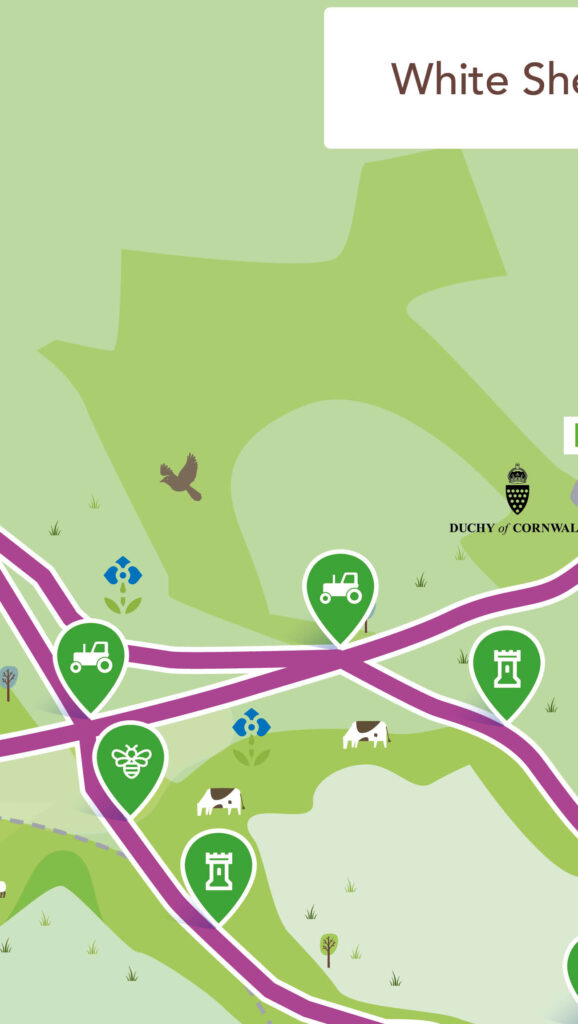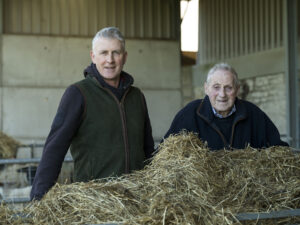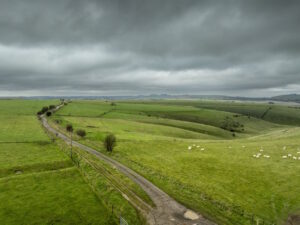
Wood Farm
About The Farm
Wood Farm is farmed by the Coward family and is currently managed by Richard Coward who took over the tenancy from his father in 2006.
Wood Farm is situated within the Cranbourne Chase National Landscape (formerly called Area of Outstanding Natural Beauty).

Richard Coward and his father Rodney – photo credit: Charles Sainsbury-Plaice
The farm consists of permanent pasture and arable land. The pasture is grazed by sheep – Scotch Mules and Suffolk Mule crosses. The arable land includes crops such as spring sown diverse grazable cover crops in our arable rotation to build fertility over the summer months.
You may spot sheep grazing on some of the arable land. This is an old practice known as the Golden Hoof. Sheep graze on cereal crops during the initial growth, reducing the need for fungicide, removing diseased leaves and adding nutrients directly back to the soil.

A view over Wood Farm – photo credit: Charles Sainsbury-Plaice
The surrounding arable land helps to support wildlife, providing seeds and insects as food and a nesting habitat for ground nesting birds such as Skylarks and Lapwings. Many of the fields have margins around them. These have been sown with mixes of grasses and wildflowers, providing pollen and nectar for pollinators, such as bees and butterflies and habitat ‘corridors’ across the landscape.
Nature
The farmers at Wood Farm manage part of White Sheet Hill Site of special scientific interest (SSSI).

A female Kestrel – photo credit: National Trust Images, Barry Edwards
Richard’s sheep graze this special habitat from July to December. This allows flowers to set seed and for any longer grasses to be grazed off, so they don’t compete with the wildflowers in the following spring and summer.
By carefully managing the grazing, the farm has seen an increase in butterflies on the farm, including the nationally restricted Adonis Blue, the food plant of which, the Horseshoe Vetch, is widespread on White Sheet Hill.
Other animals which also make use of the downland and scrub on Wood Farm include birds such as Skylark, Yellowhammer, Green Woodpecker and Kestrel. Mammals such as Field voles, Rabbits, Roe Deer and Brown Hares are also present on Wood Farm. Reptiles include Common Lizards, Slow-Worms and Adders.

Adder, Common European Viper – photo credit: National Trust Images, Barry Edwards
The farm is part of the Wessex Tree Sparrow Species Recovery Project with nest boxes located around the farm buildings and surrounding woodland copses.
History
This landscape is historically rich and some of the historical features present at Wood Farm include part of White Sheet Camp, a neolithic enclosure dating back to 3,000 BC. – a similar age to Stonehenge.
There is also an Iron Age hill fort located at White Sheet Camp. It comprises a neolithic causewayed camp, a series of Bronze Age barrows and a large Iron Age hill fort. Neolithic enclosures of this type are quite rare.
Countryside Code
Remember the Countryside Code
- On Open Access land, you must put your dog on a lead around livestock. Between 1 March and 31 July, you must have your dog on a lead on Open Access land, even if there is no livestock on the land. These are legal requirements
- Please leave gates and property as you find them. Close the gate so as that livestock do not escape.
- Please do not block access to gateways or driveways when parking as the farmers looking after this landscape need 24/7 access.
- Take your litter home – leave no trace of your visit.